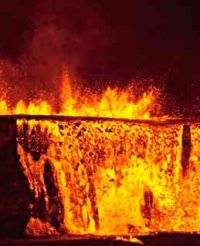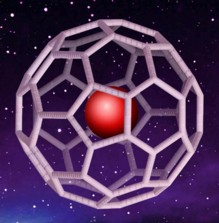|
250 million years ago something unknown wiped
out most life on our planet. Now scientists are finding buried clues
to the mystery inside tiny capsules of cosmic gas.
by Patrick L. Barry
It was almost the perfect crime.
Some perpetrator - or perpetrators - committed murder on a scale unequaled
in the history of the world. They left few clues to their identity,
and they buried all the evidence under layers and layers of earth.
The case has gone unsolved for years - 250 million years, that
is.
But now the pieces are starting to come together,
thanks to a team of NASA funded sleuths who have found the "fingerprints"
of the villain, or at least of one of the accomplices.
The terrible event had been lost in the amnesia
of time for eons. It was only recently that paleontologists, like
hikers stumbling upon an unmarked grave in the woods, noticed a
startling pattern in the fossil record: Below a certain point in
the accumulated layers of earth, the rock shows signs of an ancient
world teeming with life. In more recent layers just above that point,
signs of life all
but vanish.
Somehow, most of the life on Earth perished in a
brief moment of geologic time roughly 250 million years ago. Scientists
call it the Permian-Triassic extinction or "the Great Dying" - not
to be confused with the better-known Cretaceous-Tertiary extinction
that signaled the end of the dinosaurs 65 million years ago. Whatever
happened during the Permian-Triassic period was much worse: No class
of life was spared from the devastation. Trees, plants, lizards,
proto-mammals, insects, fish, mollusks, and microbes - all were
nearly wiped out. Roughly 9 in 10 marine species and 7 in 10 land
species vanished. Life on our planet almost came to an end.

Photo courtesy Dick Rasp/National Park Service.
The Earth
was engulfed in widespread volcanism at the time of the
extinction.
|
Scientists have suggested many possible
causes for the Great Dying: severe volcanism, a nearby supernova,
environmental changes wrought by the formation of a super-continent,
the devastating impact of a large asteroid - or some combination
of these. Proving which theory is correct has been difficult. The
trail has grown cold over the last quarter billion years; much of
the evidence has been destroyed.
"These rocks have been through a lot, geologically
speaking, and a lot of times they don't preserve the (extinction)
boundary very well," says Luann Becker, a geologist at the University
of California, Santa Barbara. Indeed, there are few 250 million-year-old
rocks left on Earth. Most have been recycled by our planet's tectonic
activity.
Undaunted, Becker led a NASA-funded science team
to sites in Hungary, Japan and China where such rocks still exist
and have been exposed. There they found telltale signs of a collision
between our planet and an asteroid 6 to 12 km across - in other
words, as big or bigger than Mt. Everest.
Many paleontologists have been skeptical of the theory that an asteroid
caused the extinction. Early studies of the fossil record suggested
that the die-out happened gradually over millions of years - not
suddenly like an impact event. But as their methods for dating the
disappearance of species has improved, estimates of its duration
have shrunk from millions of years to between 8,000 and 100,000
years. That's a blink of the eye in geological terms.
"I think paleontologists are now coming full circle and leading
the way, saying that the extinction was extremely abrupt," Becker
notes. "Life vanished quickly on the scale of geologic time, and
it takes something catastrophic to do that."

Image courtesy Luann Becker.
The carbon
atoms in a fullerene molecule are arranged in a spherical
pattern similar to a geodesic dome. (Geodesic domes were
invented by Buckminster Fuller, hence the name of the molecules.)
This shape allows the fullerenes to trap gases inside.
|
Such evidence is merely circumstantial - it doesn't
actually prove anything. Becker's evidence, however, is more direct
and persuasive:
Deep inside Permian-Triassic rocks, Becker's
team found soccer ball-shaped molecules called "fullerenes" (or
"buckyballs") with traces of helium and argon gas trapped inside.
The fullerenes held an unusual number of 3He
and 36Ar
atoms - isotopes that are more common in space than on Earth. Something,
like a comet or an asteroid, must have brought the fullerenes to
our planet.
Becker's team had previously found such gas-bearing buckyballs
in rock layers associated with two known impact events: the 65 million-year-old
Cretaceous-Tertiary impact and the 1.8 billion-year-old Sudbury
impact crater in Ontario, Canada. They also found fullerenes containing
similar gases in some meteorites. Taken together, these clues make
a compelling case that a space rock struck the Earth at the time
of the Great Dying.
But was an asteroid the killer, or merely an accomplice?
Many scientists believe that life was already
struggling when the putative space rock arrived. Our planet was
in the throes of severe volcanism. In a region that is now called
Siberia, 1.5 million
cubic kilometres of lava flowed from an awesome fissure in the
crust. (For comparison, Mt. St. Helens unleashed about one cubic
kilometre of lava in 1980.) Such an eruption would have scorched
vast expanses of land, clouded the atmosphere with dust, and released
climate-altering greenhouse gases.
World geography was also changing then. Plate tectonics pushed
the continents together to form the super-continent Pangea and the
super-ocean Panthalassa. Weather patterns and ocean currents shifted,
many coastlines and their shallow marine ecosystems vanished, sea
levels dropped.
"If life suddenly has all these different things
happen to it," Becker says, "and then you slam it with a rock the
size of Mt. Everest - boy! That's just really bad luck."
Was the "crime" then merely an accident?
Perhaps so. Nevertheless, it's wise to identify the suspects - an
ongoing process - before it happens again...
|
